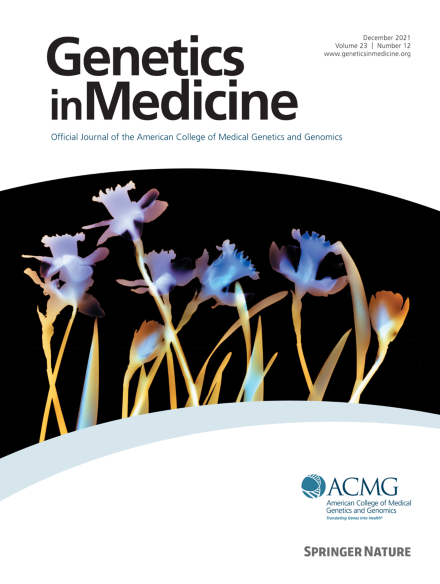The 2023 medical genetics workforce in the United States
IF 6.2
1区 医学
Q1 GENETICS & HEREDITY
引用次数: 0
Abstract
Purpose
To characterize the 2023 medical genetics and genomics workforce in the United States—comprising clinical geneticists, genetic counselors, genetic nurses, genetic physician assistants, laboratory geneticists, and metabolic dietitians—to inform genetics workforce efforts.
Methods
National genetics membership or board-certification organizations distributed an electronic survey to medical genetics professionals in early 2023. Questions were derived from prior workforce surveys and by a workgroup led by the National Coordinating Center for the Regional Genetics Networks.
Results
Of the 3070 medical genetics professionals who responded, 66.0% were genetic counselors, 15.4% were clinical geneticists, 12.2% were laboratory geneticists, 4.7% were metabolic dietitians, and 1.7% were genetic nurses or physician assistants. The respondents identified as White (76.1%) and women (84.7%); there were statistically significant differences between disciplines. Forty percent worked in academic centers; 55.3% worked 41+ hours per week. Nearly 11% of respondents provided services in a language other than English. Despite 34.7% of respondents experiencing some burnout, most had no plans to leave the field (94.4%) within the next year.
Conclusion
The medical genetics community needs to advance workforce initiatives to support current personnel and attract new and diverse individuals to the field to serve patients and their families.
2023年美国医学遗传学工作人员。
目的:描述2023年美国医学遗传学和基因组学工作人员的特征——包括临床遗传学家、遗传咨询师、遗传护士、遗传医师助理(PAs)、实验室遗传学家和代谢营养师——为遗传学工作人员的工作提供信息。方法:国家遗传学会员或委员会认证组织于2023年初向医学遗传学专业人员分发电子调查。这些问题是由国家区域遗传网络协调中心(NCC)领导的一个工作组从先前的劳动力调查中得出的。结果:在3070名医学遗传学专业人员中,66.0%为遗传咨询师,15.4%为临床遗传学家,12.2%为实验室遗传学家,4.7%为代谢营养师,1.7%为遗传护士或遗传护理师。被调查者为白人(76.1%)和女性(84.7%);不同学科之间的差异有统计学意义。40%的人在学术中心工作;55.3%每周工作41小时以上。近11%的受访者使用英语以外的语言提供服务。尽管34.7%的受访者感到有些倦怠,但大多数人(94.4%)在未来一年内没有离开这个领域的计划。结论:医学遗传学社区需要推进劳动力计划,以支持现有人员,并吸引新的和多样化的个人到该领域为患者及其家属服务。
本文章由计算机程序翻译,如有差异,请以英文原文为准。
求助全文
约1分钟内获得全文
求助全文
来源期刊

Genetics in Medicine
医学-遗传学
CiteScore
15.20
自引率
6.80%
发文量
857
审稿时长
1.3 weeks
期刊介绍:
Genetics in Medicine (GIM) is the official journal of the American College of Medical Genetics and Genomics. The journal''s mission is to enhance the knowledge, understanding, and practice of medical genetics and genomics through publications in clinical and laboratory genetics and genomics, including ethical, legal, and social issues as well as public health.
GIM encourages research that combats racism, includes diverse populations and is written by authors from diverse and underrepresented backgrounds.
 求助内容:
求助内容: 应助结果提醒方式:
应助结果提醒方式:


